|

The "Gweni Fada" structure in Chad is
NOT
an Astrobleme
Norbert Brügge, Germany
Dipl.-Geol.
The Gweni Fada and the
Aorounga
structures in Chad (Africa) are classified as astroproblemes by certain dogmatic
scientists due to dubious evidence, e.g. planar deformations in quartz grains.
It should meanwhile be known that such "evidence" can be completely nonsensical
in this context. It has been shown that such deformations can also be generated
by volcanic shock waves of different power, this applies to both PFs and PDFs.
PDFs are only genuine if certain features can be verified by a TEM examination.
Even then, PDFs are not yet a feature of an impact, because the PDF-paradigm
is based on findings in impact structures in question. Likewise, the necessary
shock forces for the formation of PDFs cannot only be induced by an impact.
The same applies to so-called impact breccia, which are used again and again
without precise examination. Even a centrale uplift is not suitable as proof,
the so-called "target rocks" are not a "pudding" after all.The mostly of the
structures defined as impact craters around the world are not anyway.
Thus, it is appropriate to
fathom the true origin of at the Gweni-Fada crater, which has hardly been
visited or examined. A comprehensive description of the geological and structural
conditions found was published by Alain Beauvilain (1996). However,
the conclusions must be viewed critically.
Andras Zboray (Hungary) and Ursula Steiner (Switzerland)
are now providing new observations and a number of photos (also of breccias)
from a trekking tour in 2021. They provide further good evidence of the actual
origin of Gweni-Fada.
|
Alain Beauvilain (1996)
Quote (translated)
"The Gweni Fada structure
is hosted in paleozoic period Spirophyton-sandstones and is approximately
13 kilometers in diameter. The structure is characterized primarily by
its asymmetry and a uplifted central zone. From a morphological point
of view, the structure consists of a complex central zone with chaotic
relief and a more regularly formed outer zone. There is a sandy depression
between the outer and central zones. It is crescent-shaped and has a maximum
width of 3 kilometers. This depression is about 150 m deeper compared
to the ridgeline of the outer zone.
|
|
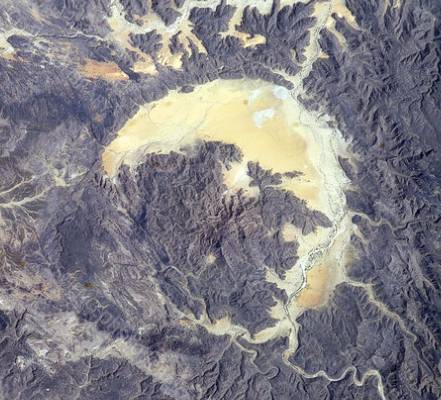
|
At the bottom of the
the structure, along north to north-west, runs a 5km slope of up to 150m
in height of slumped sandstone. To the south (where a depression between
the rim and the uplift is absent, the outer boundary is more confusing
and irregular. The depression itself is occupied by a series of sloping
terraces, formed by narrow, more or less inclined slabs that are close
together.
The central complex contrasts with
its tormented, chaotic relief with no discernible order. Its outline is
very irregular. The central complex exceeds the height of the outer rim
of the structure by up to 200m.
It consists of many adjacent blocks arranged in two roughly concentric
sets: A heart with all vertices and a crown. There are only sandstone
formations whose stratification remains recognizable. The core of the
structure is the most distorted part. They consist of (more or less coarse)
sandstone, sometimes with quartz dragees. The trace fossil Harlania
was found in three locations there. These fossils are known at Ennedi
beneath the sandstones with the trace fossil Spyrophyton, formations
attributed to the Silurian or Ordovician.
The inner crown is formed by a series
of large blocks surrounding the heart. The slopes are variable, but less
than 45�, and are usually directed towards the outside of the structure.
The heart of the structure is not in the center but shifted to the south.
Despite its chaotic appearance and irregularity at first glance, this
set represents a structural dome with the oldest formations in the center.
Its breakdown into faulty blocks results from a large uplift.
Hardened
breccias emerge as veins or dikes. It is remarkable that apart from these
fracture zones, the sandstones have undergone macroscopically hardly visible
changes. No impactites were found during exploration routes within the
structure.
However, the sandstones in the
heart of the central-complex have often acquired a quartzite-like appearance
through compaction. A sample of shocked quartz was also found there.
Koeberl et al. (2005) --
Unfortunately, only a very limited number of samples were available for
our (planar deformation) study. These samples are quartzite, �hematite-stained
sandstone�, a pebbly sandstone, and a quartz conglomerate. These samples
are derived from the central disturbed area, as well as from the outer
margin of the ring depression (fluvial terrace ?).
|
New insights
Detailed descriptions in the
publication from 1996 in connection with new photos and observations allow
a completely different conclusion to the origin of the crater. As is so often
the case with such structures, classification as an astroblem is without substance
and is therefore wrong.
In the assessment are the following
characteristics:
-
Undisturbed horizontally bedded sandstone strata in
the outer walls of the structure. No signs of impact fragmentation.
-
No ejecta outside the structure.
-
A depression within the crater filled with fluvial
deposits.
-
A complete and undisturbed sandstone complex has
broken down from the northern edge of the structure and tilting strangely
inward.
-
A central uplift that appears to be connected to
the western edge of the structure.
-
Undulated or tilted sandstones in an outer zone, steeply
erected and shattered sandstones in a chaotic inner zone of the uplift.
-
Gaps with sub-volcanic filled magnetite flow and
brecciated quartz pieces within.
-
Sub-volcanic dissolution of the sandstone matrix
with partial bleaching found at the foot of the Uplift.
-
Metamorphic overprint of sandstones in the uplift
visible by pre-sunrise reflections.
-
No igneous rocks have been found to date. But there
is an unexplored elevated fault line about 10 km long just SW of the structure
that may be filled with igneous material.
At first it is obvious that
the outer edge of the structure shows no traces of a catastrophic event.The
sandstones are in their original condition and bedded horizontally. In contrast,
the central uplifted elevation consists of a tangle of broken and partly changed
sandstones indicating a destructive und thermal force. The fairy tale that
has been widespread again and again that impact craters can be recognized
by a central uplift can safely be ruled out when looking for the cause. A
challenge for the analysis was the sickle-shaped sandy depression between
the outer edge and the central uplift, but this can ultimately be explained
as a break-in zone. This is documented by the inclined and seamless immersion
of slipped sandstone formations on the northern wall.
The central uplift consists
of debris from sandston bedrock that was uplifted up by an igneous intrusion.
Since no igneous rocks have been found so far, it can be assumed that the
intrusion has not reached the surface or is hidden under the debris pushed
in front of it. The asymmetry in the structure indicates that the intrusion
had an angled rise. The sickle-shaped depression is a collapse structure in
an emptying magma chamber, and with the sandstones from above filled again
with terrace-like slipped blocks from the today's edges.
There is no depression on the western side of the asymmetrical structure because
the plug collided with the sandstone there and caused probably a crushing
zone there.
The found breccias come from
the central structure are an important indication of volcanic activity in
the subsurface. The are originate from gaps partially filled with a magnetite-flow.
This contains angular quartz pieces (cherts) from the Precambrian basement.
This composition suggests that it is a sub-volcanic processed
Banded Iron Formation (BIF).
The planar features in quartz
pieces (found by V. & B.) from the inner central zone of the uplift are only
simple PFs and an indication of shock waves that were induced by a raised
magma.
Adjacent sandstones have changed
by a methamorhose. On site we can also see alternately bleached or rusted
areas in the sandstones, which can only arise by a hydrothermal (better hydro-volcanic)
process and happens slowly.
From an analytical point of
view, the Gweni-Fada structure is nothing other as a collapsed dome with a
hidden magmatic intrusion (plug), and the breccias come from gaps with hydro-volcanic
infill.
Conclusion
The Gweni-Fada structure
is originally a dome-like elevation in the sandstone strata caused by a subsurface
magma chamber that did not reach the surface. The central uplift is a plug
within the sandstone dome was formed by partially rising magma. The occurrence
of gaps with magnetite flow and breccias with shocked components from the
basement (BIF) are proof that we are dealing here exclusively with volcanic
forces.
The current state of the structure can be explained by the fact that after
the magma chamber was emptied, the structure collapsed and finally the central
depression arose. The sharp outer edges of the structure and above all the
layers that slided down at the northern edge and sloped inwards also speak
in favor of such scenario. In a slow process, these have tilted inwards, broken
off from the edge and partially sunk into the inner structure..
The central uplift seems to be little affected by the secondary sinking. This
means that it is anchored in a solidified volcanic plug.
Finally, it is also very likely that both the Gweni-Fada and the very similar
Aorounga structure have something to do with volcanism in the Tibesti of northern
Chad, the most prominent feature of which is the Emi Koussi stratovolcano.
The Emi Koussi was active 2.4 and 1.3 million years ago.
Emi Koussi was the pulsating
valve in a far-reaching magna chamber. Aorounga and Gweni-Fada are products
of temporary overpressure but have not reached an eruptive stage.
Photo Gallery (1)
Source: Alain Beauvilain (1996)
|
|

|
|
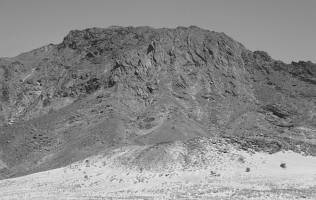
|
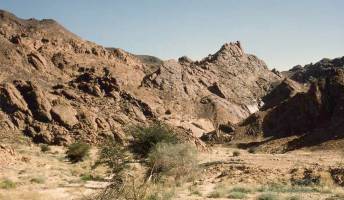
|
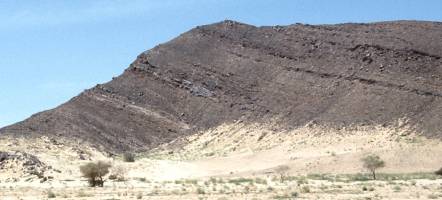
Inward tilted less disturbed layers at the outer
edge of the central uplift
|
|
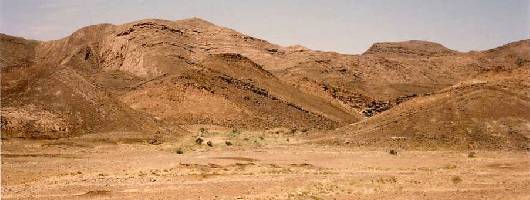
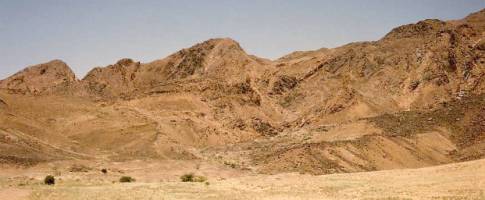
Uplift from south
|
Photo Gallery (2)
Source: Andras Zborya & Ursula Steiner (2021)
|
Outer edge

Outer edge without tectonically stressed layers
(Eastern side)
|
Central Uplift
Sub-volcanic breccia,
probably from a gap filling in the the central uplift, found on a gravel terrace
in the depression
|
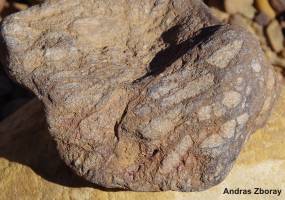
Gravel terrasse: Pulpy dissolved mass with angular
basement pieces
|

Before Sunrise: We see the metamorphic quartzitization
of Sandstones
|
|
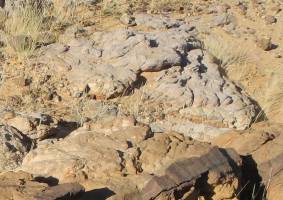
Pulpy dissolved sandstone hydro-volcanic bleached
|

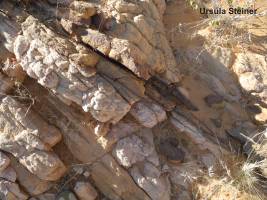
Hydro-volcanic bleached and rusted sandstone layers
|
References:
Becq-Giraudon J-F., Rouzeau O., Goachet E & Solages S.
-- Impact hyperv�loce d'une m�t�orite g�ante � l'origine de la d�pression
circulaire d'Aorounga au Tchad (Afrique).
C.R. Acad. Sci. Paris, t. 315, S�rie II,
pp. 83-88. (1992)
Vincent P.M. & Beauvilain A. -- D�couverte d'un nouveau
crat�re d'impact m�t�oritique en Afrique : l'astrobl�me de Gweni-Fada (Ennedi,
Sahara du Tchad).
C.R. Acad�mie des Sciences, Paris, t. 323, s�rie IIa, pp. 987-997. (1996)
Beauvilain A. -- L' astrobleme de Dweni-Fada,
Ennedi quest. (1996)
https://meteoritestchad.monsite-orange.fr/page-55ca0eb105df4.html
Koeberl Ch., Reimold W.U., Cooper G., Cowan D. & Vincent
P.M. -- Aorounga and Gweni Fada impact structures, Chad : remote sensing,
petrography, and geochemistry of target rocks. Meteoritics and planetary Science
40, Nr 9/10, pp 1455-1471. (2005)
Zboray, A. --Ennedi Expedition, Chad, 19th November
- 8th December, 2021
https://fjexpeditions.com/frameset/past.htm
Brügge, Norbert
�
Clayton Craters and other crater-shaped structures in Egypt and Libya
Brügge, Norbert
�
Archean Basement outcrops of East Sahara Ghost Craton in the Western Desert
(Uweinat-Howar Uplift)
|